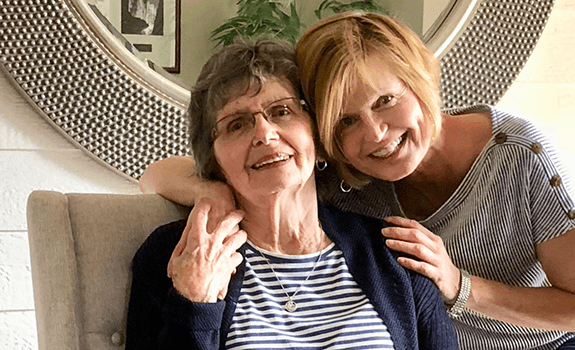January 17, 2023
CAA: Notes from the Frontlines

By Julie Gregory, Chief Health Liaison for Apollo Health
My holiday took an unexpected turn the day after Thanksgiving. My husband and I were visiting my son in Tennessee when my 21-year-old niece called me screaming, “Grandma needs an ambulance. I don’t have her address.” I didn’t stop to ask questions. I immediately called 911, who was able to dispatch an ambulance to my mother’s home in Indiana. It took around 15 minutes before the ambulance showed up. As soon as I hung up, I called my 84-year-old mother, who answered. (Thank goodness!) At first, I was reassured, but then I began to notice that her words were very jumbled. She thought she was speaking normally, but she was speaking semi-nonsensically. I immediately suspected a stroke and told her over and over. “Mama, I love you. Please unlock your door and lie down while we chat on the phone.” She did. I told her that some nice people were going to come to help her, at which point, she insisted that she didn’t need help, and she re-locked the door. (Oh no!) I begged her to unlock it, and she finally complied. When the EMTs arrived, I shared my suspicion with them, and they assured me she would be checked out. I immediately began my eight-hour trek back home, unsure whether or not she would even be alive when I arrived.
Her local hospital confirmed a medium-sized left lobar hemorrhagic stroke and promptly transferred her several hours away to the nearest Neuro ICU. I alerted Dr. Bredesen to what was happening, and he immediately suspected cerebral amyloid angiopathy (CAA) based upon the location of the bleed and her ApoE4 status. From our work together, I knew that most people lose consciousness, and many don’t survive these events. You can imagine my relief when I found my mother alert and awake when I arrived — a very good sign. My being able to hug her again felt like a miracle. She was still speaking nonsensically, substituting “hamburger” for headache, “chickens” for her children, and apples for her “pills,” but she was alive. We spent a few hours with her and checked into a nearby hotel, and my already chaotic life (see Three Things to Hang Onto) has been turned upside down ever since. She spent a few weeks in the hospital, then moved onto a rehabilitation facility, and we’re in the midst of trying to figure out the next steps. Prior to this event, her cognition was pretty good, around 27 on a MoCA. She had been living independently, doing volunteer work, driving, and even balancing her checkbook to the penny every month. She’s made tremendous strides since the event. She’s physically pretty strong but struggles with speech (expressive aphasia) and has taken a huge cognitive hit. On good days, she knows her birthdate and her children’s names.
The fact that she got medical attention very quickly was instrumental in saving her life. She had been on a walk when she recognized she was in crisis. She was somehow able to drive home (a few blocks) and get back into her house. She told us that she knew she was “bad” (her description), so she went home and locked the door until she felt better. She miraculously was able to text (albeit nonsensically) with my niece ending with the words “HELP.” My brilliant niece recognized that something was seriously wrong and knew she needed medical help. Retrospectively, I suspect that she likely had been experiencing a cerebral bleed for days, maybe weeks leading up to the event. She had been getting very emotional, often screaming and crying when we spoke on the phone. I also noticed that her cognition had taken a downward turn prior to the stroke. I remember using the word “paradoxical” in one of our conversations, and she became very angry because she said I was speaking down to her. (This from my mother, who completed the NYT crossword puzzle every morning!) In hindsight, all of these were warning signs that something was seriously wrong. She had also been dealing with pretty severe mast cell activation (MCA) in the months before the stroke, so I had mistakenly been attributing all of these changes to that and the effect of her anticholinergic medications. I now recognize them as being symptomatic of the left lobar bleed. (Interestingly, Dr. Bredesen believes that the MCA — which can cause vascular permeability — may very well have been a contributing factor.) Her MRI revealed that she also had previous bleeds in her brain. All of this further confirmed the diagnosis of CAA.
Years ago, when I first began working with Dr. Bredesen, he had warned me about what he described as a relatively rare condition called CAA. Because I work with many ApoE4 carriers, he wanted me to especially alert male 4/4s (who are perhaps the most vulnerable) to be on the lookout for this. His primary warning to them was to avoid fish oil which can thin the blood and make them more susceptible to a brain bleed. After my mother’s experience, I’m beginning to wonder if it’s more common than we previously thought. Perhaps all E4 carriers, male and female, should be alert to this condition. Of course, as a 4/4, I’m particularly nervous about whether this could affect me and my siblings.
Per Dr. Bredesen’s advice, we will try to get specialized MRIs called MP-RAGE to look for evidence of current or old bleeds. Frighteningly, my mother’s neurologist has informed us that health insurance typically will not cover this for pure exploration. We actually need to have symptoms of a current bleed to qualify for this type of MRI. (Yikes, mainstream medicine at its best!) I’m especially worried for my youngest brother, who had his aorta replaced years ago due to a familial connective tissue disorder, as he’s on long-term coumadin therapy.
When I learned my 4/4 status, I thought I had met “the enemy” that would ultimately take me down. Now, I know my potential adversary more specifically. My goal is to learn all that I can about CAA to save my life and my family members’ lives. I plan to share everything that I learn with you to help keep everyone in our community as safe as possible.
All About CAA
What is CAA?
● As with Alzheimer’s (AD), we have no idea if the model describing this condition is correct. Currently, researchers believe that amyloid proteins build up in the arteries in the brain, which ultimately can become weakened and rupture.
Who should be concerned?
● Anyone diagnosed with Alzheimer’s (AD). Statistics suggest that 50% of those with AD also have CAA.
● Anyone who is ApoE4+. While CAA is more likely in those with two copies of E4, all E4 carriers should suspect this condition.
How to get diagnosed.
● As with AD, a definitive diagnosis requires a brain biopsy or an autopsy, but there are some tests and many clues that can lead one to a presumed diagnosis.
● You need proof of amyloid in the brain for a diagnosis of CAA, so an amyloid PET or a lumbar puncture to verify this could be helpful. With AD and ApoE4/4, amyloid deposition in the brain could be presumed, although this isn’t 100% accurate.
● In addition to amyloid deposition, a specialized MRI (called MP-RAGE) that can accurately look for both old and new bleeds is used to diagnose this condition. As mentioned earlier, this type of MRI may be both difficult to find (especially for those outside of major metropolitan areas) and to get health insurance to cover.
● Research suggests that in addition to cerebral microbleeds and intracerebral hemorrhage, the following abnormalities on any MRI imaging: cortical superficial siderosis; white matter hyperintensities; enlarged perivascular spaces, and cerebral microinfarcts could be early indicators of CAA and warrant further investigation. [1]
If you suspect that you may have CAA, what can you do to protect yourself now?
1. Control blood pressure (BP). Avoiding hypertension is vital to both prevent and remediate Alzheimer’s, but it’s especially critical in cases of confirmed or suspected CAA. Following the Bredesen Seven will help to yield optimal BP, but those at high risk should consider medication until dietary and lifestyle strategies can be effective. Also, be on the lookout for any medication that can increase BP, such as decongestants, weight loss medication, antidepressants, and pain medication. Controlling pain, however, is very important as it can also increase BP. Please work closely with your practitioner to find the best the safest medication options.
2. Avoid medications and supplements that can thin the blood. Many people (for various reasons) need to be on blood-thinning medications. Work with your practitioner to make the safest choice. Be aware that some over-the-counter medications, such as aspirin and non-steroidal pain medication, also have this effect. Additionally, many supplements, including fish oil, algal oil, and others, are natural anticoagulants that may inhibit your body’s ability to make a blood clot when bleeding occurs. This puts E4 carriers in a conundrum as research suggests that we need more omega-3s than other ApoE genotypes. (I’ve given up my 2g of daily DHA and am now eating more low mercury wild-caught SMASH fish- sardines, mackerel, anchovies, herring, and salmon.) Carefully research all of your medications and supplements to identify those with anticoagulation properties.
3. Ensure that you’re not taking medications that are contraindicated with CAA. Research all of your current medications to identify those that could be potentially dangerous. As an example, while my mother was still in the Neuro ICU, she experienced a migraine. Her care team planned to alleviate the pain by following her current treatment plan, which included sumatriptan (Imitrex). Knowing that this drug works by constricting the blood vessels in the brain, I suspected that this might not be a good idea. Manipulating bleeding or leaky vessels felt risky to me. A quick PubMed search showed that sumatriptan had been associated with intracranial hemorrhages. [2] I was able to promptly stop them and find a safer alternative.
Ideally, we need to identify CAA as early as possible to proactively address it before it leads to a hemorrhagic stroke. As I learn more, I’ll share it in follow-up blogs. One thing I know for sure, the old version of my mother would be very proud that I’m sharing this information to keep you safe. Even though she’s still with us, I can’t begin to tell you how much I miss her. I miss calling her as I’m driving to hear about her day and to share mine. She now proudly tells everyone at her new facility that I’m her mother. It’s bittersweet … and really, really hard.
[1]https://journals.sagepub.com/doi/full/10.1177/1747493020974
[2]https://n.neurology.org/content/56/9/1243




